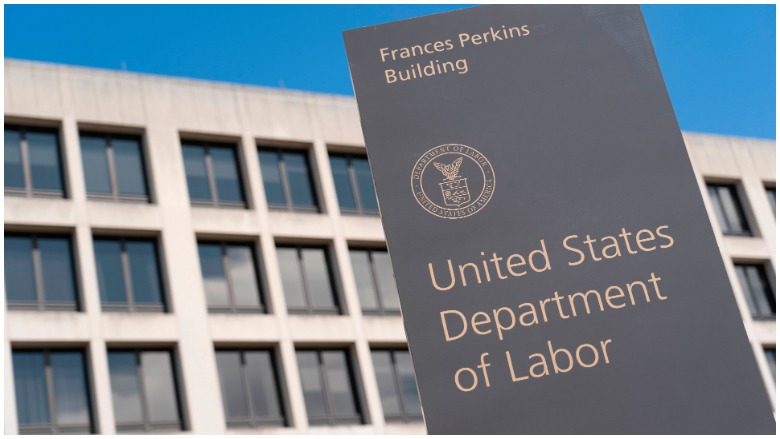
Getty The United States Department of Labor Frances Perkins Building.
Whether the White House and Congress can get a deal done to send out more stimulus checks remains to be seen, which has left many unemployed Americans relying on funds from the Lost Wages Assistance (LWA) program.
President Donald Trump announced that the Lost Wages Assistance (LWA) program would replace the weekly $600 supplement in unemployment benefits that expired at the end of July. The Federal Emergency Management Agency is the program in charge of distributing funds, which has gone smoothly in some states and had a more difficult path in others.
Some states had yet to distribute their first check at the beginning of this week.
Most States Will Be Delivering a Total of $1,800 in LWA Payments
Under the FEMA guidelines, states were required to indicate whether they would choose the $300 or $400 amount to make available to those eligible for the program; states that chose the $400 option were required to come up with state funds to add $100 to the $300 provided through FEMA.
According to a count by Heavy, there are only a few states which are expecting to distribute the $2,400 in total benefits, which means that all of the other states enrolled in the program except Kentucky, Montana and West Virginia (as well as South Dakota, which opted out of payments) will be receiving a total of $1,800 to eligible Americans in unemployment benefits. Some of those benefits have been delivered on a weekly, $300 basis, while others have been delivered in a lump sum or phased amount.
The following states are set up for $300 payments: Alabama, Alaska, Arizona, Arkansas, California, Colorado, Connecticut, Delaware, Florida, Georgia, Hawaii, Idaho, Illinois, Indiana, Iowa, Kansas, Louisiana, Maine, Maryland, Massachusetts, Michigan, Minnesota, Mississippi, Missouri, Nebraska, Nevada, New Hampshire, New Jersey, New Mexico, New York, North Carolina, North Dakota, Ohio, Oklahoma, Oregon, Pennsylvania, Rhode Island, South Carolina, Tennessee, Texas, Utah, Vermont, Virginia, Washington, Wisconsin and Wyoming.
According to the Associated Press, a FEMA spokesperson declared that states would only be receiving a full six weeks in payments. Because FEMA promised to deliver six weeks in benefits, the organization issued a statement noting that states could seek an extension to deliver funds for those weeks, calling it an “extension of the Period of Performance”:
FEMA acknowledges that states/territories may not be able to administer payments to all eligible applicants who submitted timely claims or adjudicate all timely appeals during the initial Period of Performance. For this reason, states/territories may request extensions of the Period of Performance, if necessary, to fully administer the LWA program, make all eligible payments within the total obligation awarded by FEMA and pursue recovery of fraudulent and improper payments.
Some states are still awaiting clearance for a sixth payment. You can see a list of when payments are supposed to be delivered here.
Politicians Warned That LWA Payments Were Only a Temporary Solution
CNET reported that LWA payments, even with the additional state funding, were substantially less than what the $600 weekly benefit would have provided by comparison. According to that analysis, distributing $300 weekly payments — had the money not run out — until the end of the year would have provided families with an additional $6,600 while an extension of the $600 weekly benefits until the end of the year would have provided families with $13,200.
In addition to that, many low-income Americans were ineligible for the program because the LWA program required that only those receiving a minimum of $100 in unemployment benefits would be eligible; according to a CNBC analysis of unemployment data, 5.5 million Americans were rendered ineligible due to that requirement.
The Garden Island reported that Hawaii Senator Brian Schatz said he believes the payments were only a short-term fix: “While this new funding will provide some immediate help, it’s not enough for Hawai‘i families who are struggling to make ends meet,” he said.
Arizona Congressman Greg Stanton agreed that the payments were not sufficient, according to what ABC-15 reported:
Enhanced federal benefits can only help so much, as our state offers $240 per week–the second lowest in the country and far below the national average. This is not enough to pay for rent and not nearly enough for anyone to live on–let alone live the quality of life every Arizonan deserves.
Governor – Sisloak of Nevada also said that he was unhappy with the amount which was lower than the original $600-per-week extension. “(W)hile I am grateful that the LWA program will provide assistance to some Nevadans, this new, short term benefit is simply not enough to sufficiently help all those who need it,” he said, according to a Las Vegas NBC-affiliate.
In addition to the low amount and ineligibility of many low-income families, the rollout of the program has been plagued with issues because many states had to create entirely new systems to check eligibility and prevent fraud as well as new distribution systems completely different from their existing unemployment structures. California was recently forced to temporarily shut down its unemployment system after a scathing report revealed multiple logistical and operational holes in its unemployment infrastructure.
READ NEXT: Here’s When All 50 States Plan to Distribute LWA Unemployment Payments